Stuffing is a time-honored holiday dish that is often considered the centerpiece of Thanksgiving and Christmas dinners. Whether you prefer it stuffed inside the turkey or baked separately, classic stuffing is always a crowd-pleaser. This recipe will help you achieve the ideal balance of flavors and textures—moist on the inside, crispy on the outside, and infused with savory herbs and vegetables.
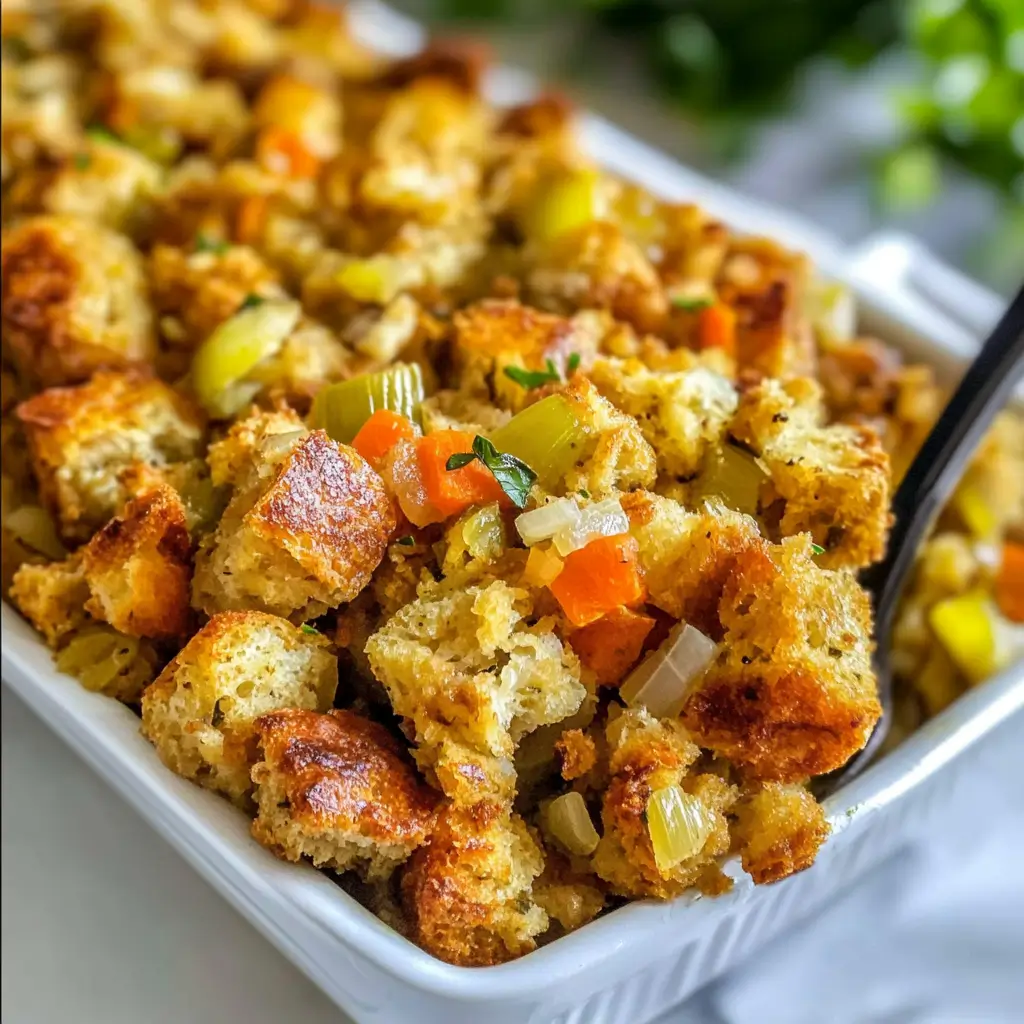
Ingredients for Classic Stuffing Recipe:
To create the perfect stuffing, it’s important to use the right ingredients. Here’s a breakdown of the essential components:
Bread: The bread serves as the foundation of your stuffing. For a traditional stuffing, you’ll need country white bread. Stale bread works best, as it holds up to the broth and doesn’t get too soggy. You can use other types of bread, such as sourdough or cornbread, for different flavors and textures.
Aromatics: Onions, celery, and garlic form the classic vegetable base for stuffing. They provide a savory depth of flavor that infuses the bread mixture, creating a rich and aromatic stuffing.
Herbs: Fresh herbs such as sage, thyme, and parsley are key to bringing that distinct Thanksgiving flavor to your stuffing. These herbs add freshness and warmth, complementing the savory elements in the dish.
Broth: Chicken or turkey broth is used to moisten the bread, providing a savory foundation that infuses the stuffing with rich flavor. Using low-sodium broth helps control the salt content of your dish.
Eggs: Eggs are an essential ingredient in classic stuffing recipes. They act as a binder, holding everything together and creating a cohesive texture.
Fat: The addition of turkey drippings or butter adds moisture and richness to the stuffing. Turkey drippings add a deeper flavor, but butter can be used as a substitute for a milder, creamier taste.
Add-ins (Optional): While this recipe is simple, feel free to add variations like sausage, apples, or nuts to elevate the flavor. Sausage provides a savory, meaty element, while apples add a subtle sweetness, and nuts like walnuts or pecans bring a crunchy texture.
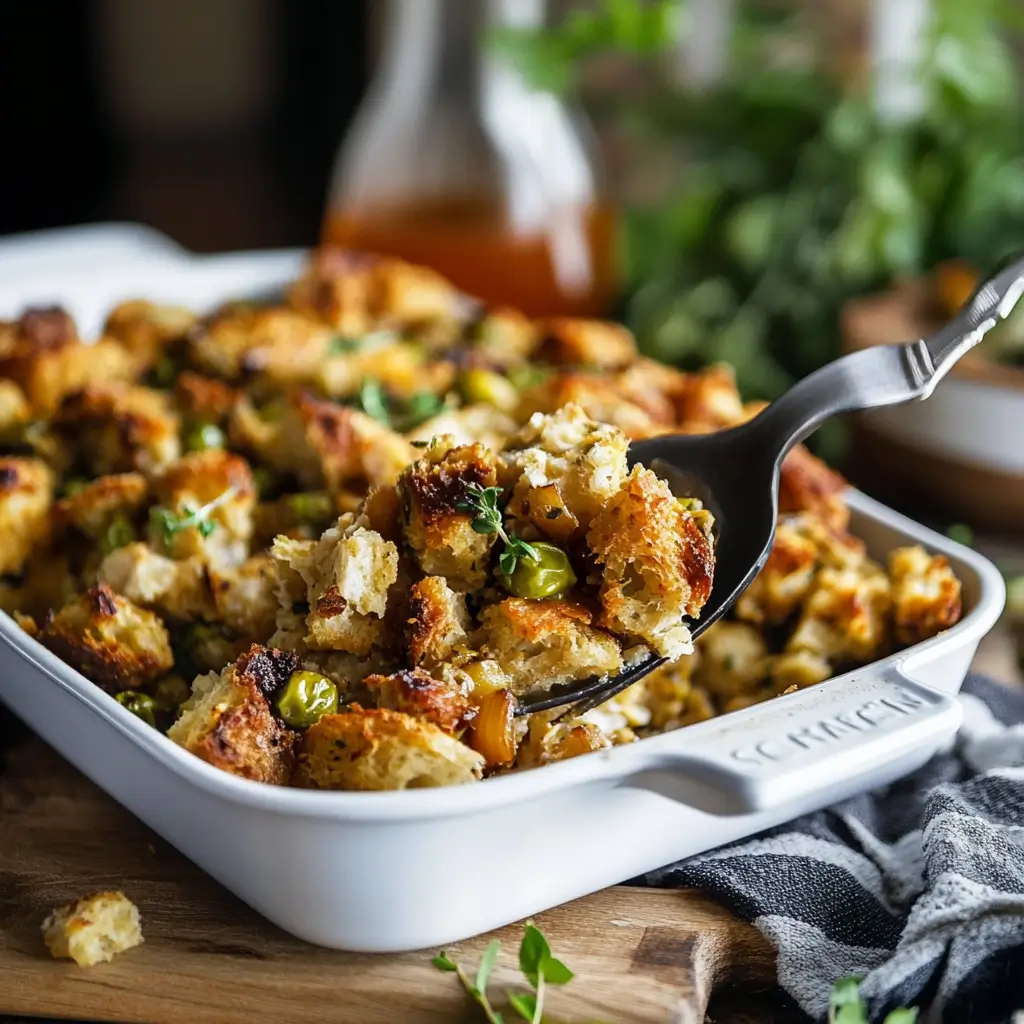
Step-by-Step Instructions for Classic Stuffing:
Making stuffing is easier than it sounds. Follow these simple steps to create the perfect stuffing for your holiday meal.
Prepare the Bread:
If you don’t have stale bread, slice the bread into cubes and dry it out in the oven. Preheat your oven to 300°F (150°C), spread the bread cubes in a single layer on a baking sheet, and bake for 15–20 minutes, stirring halfway through. This will help the bread absorb the broth without becoming too soggy.
Cook the vegetables:
In a large skillet or Dutch oven, melt butter over medium heat. Add the chopped onions and celery and cook for about 5 minutes until the vegetables are soft. Add minced garlic and cook for another 2 minutes, being careful not to let the garlic brown.
Add Broth and Herbs:
Add your choice of low-sodium chicken or turkey broth to the skillet, along with fresh chopped sage and thyme. Stir well and bring to a simmer. Once everything is well combined, remove from the heat.
Combine the ingredients:
In a large mixing bowl, whisk the eggs with fresh parsley, salt, and pepper. Add the dried bread cubes and the vegetable-broth mixture to the bowl, stirring gently until the bread is evenly coated and moist but not soggy. If the mixture looks too dry, add more broth, a little at a time, until the bread absorbs the liquid.
Transfer to a baking dish:
Grease a 9×13-inch baking dish with butter and transfer the stuffing mixture into the dish. Dot the top with additional butter or turkey drippings to enhance the flavor. If you prefer a crispier top, leave it uncovered while baking.
Bake the stuffing:
Preheat your oven to 375°F (190°C). Cover the baking dish with aluminum foil and bake for 30 minutes. After 30 minutes, remove the foil and continue baking for another 25–30 minutes, until the top is golden brown and crispy.
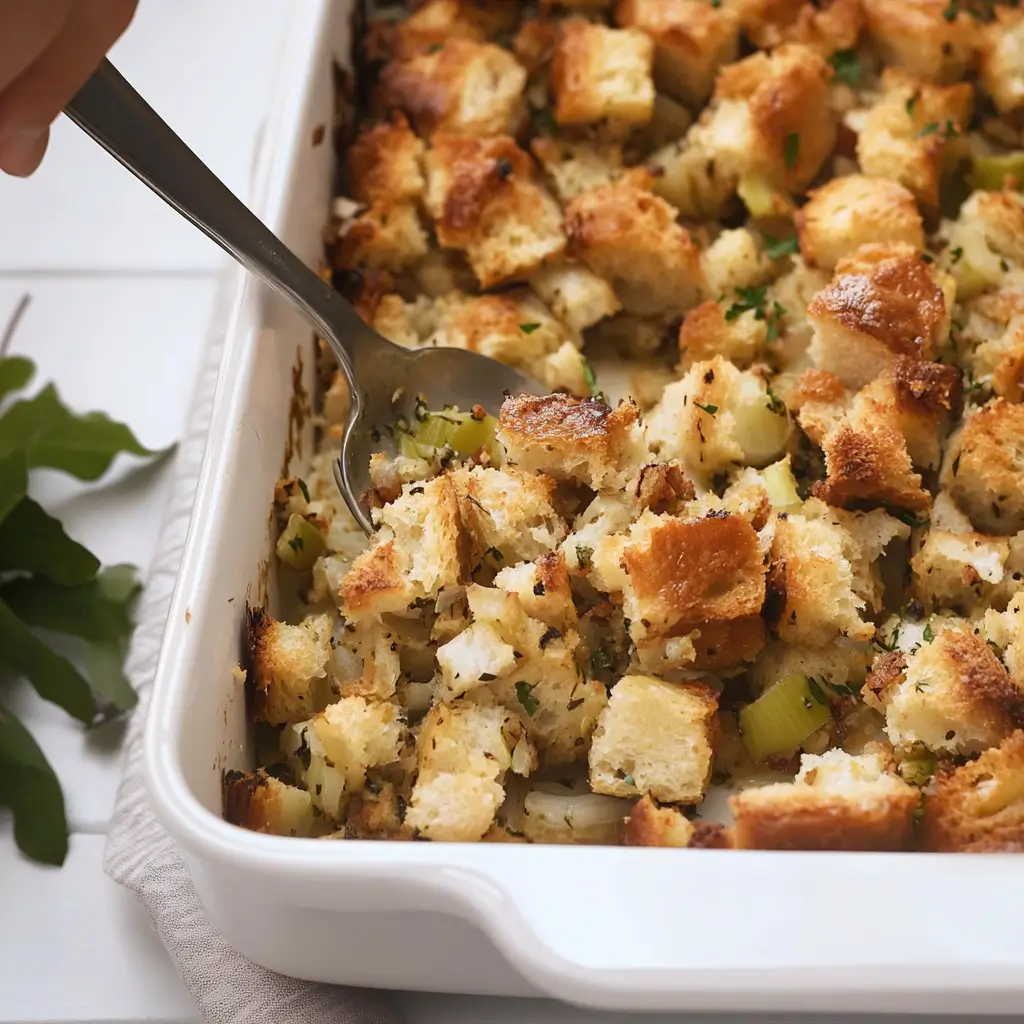
Tips for Perfect Stuffing:
Use stale bread: Fresh bread doesn’t hold up well in stuffing. Stale bread or dried bread cubes are key to achieving the perfect texture.
Avoid Overcooking the Vegetables: When cooking the onions and celery, be sure not to brown them. You want them tender, not caramelized.
Balance the Liquid: Be cautious with the amount of broth you add. You want the stuffing to be moist but not swimming in liquid. Let it rest for a few minutes after mixing to see how much liquid the bread absorbs before adding more.
Make Ahead: If you’re prepping for a big dinner, you can assemble the stuffing a day or two in advance. Simply store it in the refrigerator, covered, and bake it on the day of your event.
Add Flavorful Twists: Customize your stuffing by adding cooked sausage, diced apples, or roasted chestnuts. These additions add variety and unique flavors.
How to Make the Perfect Classic Stuffing
Now that you know the essential ingredients, it’s time to turn them into a stuffing that will impress your guests. Follow this easy step-by-step process to ensure your stuffing comes out just right:
Step 1: Prepare Your Bread Start by cutting your bread into cubes. Ideally, the bread should be a day or two old for optimal results, but if you’re short on time, drying it out in the oven at 300°F for about 10-15 minutes works too. You want the cubes to be firm and crisp, as they will absorb the broth more effectively.
Step 2: Sauté Your Veggies In a large pan, melt your butter over medium heat. Add the onions and celery, season with salt and pepper, and cook for 5-7 minutes, stirring occasionally, until the vegetables are soft but not caramelized. Add the garlic and cook for another 2 minutes to release its fragrance. This is where the savory aroma starts to build.
Step 3: Combine and Mix In a large mixing bowl, combine your bread cubes with the sautéed vegetables. This is where you can also add any optional extras, such as dried cranberries or sausage, for variation. Once mixed, pour in your broth little by little until the bread is evenly moistened but not swimming in liquid. Stir in the beaten eggs, herbs, and any additional seasonings.
Step 4: Bake Your Stuffing Transfer your stuffing mixture into a greased baking dish. Cover with foil and bake in a preheated oven at 375°F for about 30 minutes. After that, remove the foil and bake for another 25-30 minutes to achieve a golden-brown and crispy top. The stuffing should have a moist interior and a crunchy exterior, with the herbs and veggies evenly distributed throughout.
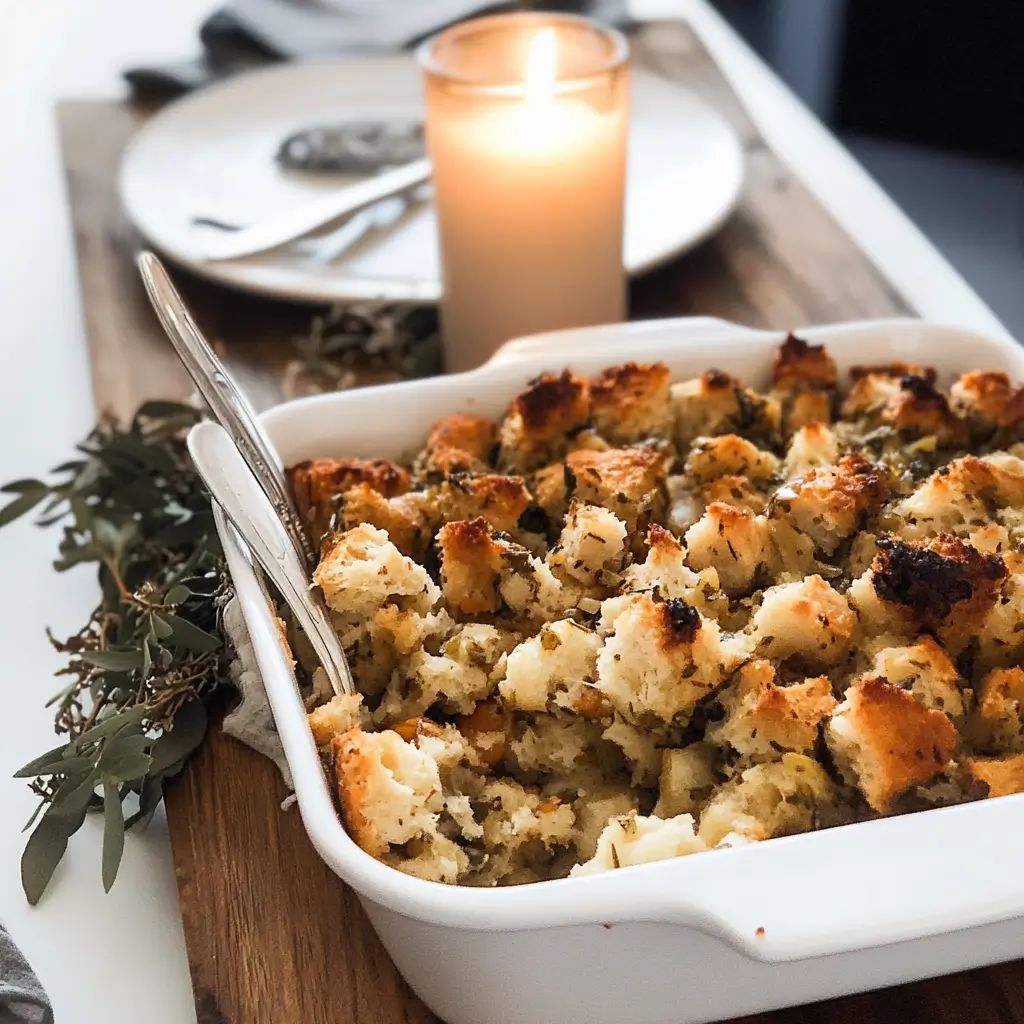
Can You Make Stuffing in Advance?
Absolutely! One of the best things about stuffing is that it can be prepped in advance, saving you time on the big day. There are two main ways to do this:
Prep the Ingredients—If you want to ensure your stuffing is fresh and flavorful, prepare all the components (bread cubes, sautéed vegetables, herbs, and broth) in advance. Store them separately in the fridge and assemble everything on the day of baking. This is a great way to save time while still keeping the stuffing fresh.
Assemble and Refrigerate—For an even easier option, you can prepare the entire stuffing, cover it with foil, and refrigerate it up to one day in advance. Just allow it to come to room temperature for 30 minutes before baking. This method is a great time-saver and ensures that the stuffing will be hot and ready to go when you need it.
How to Make Stuffing Crispy
If you prefer crispy stuffing, there are a few key steps to follow:
Increase the Oven Temperature—After the initial baking with foil, uncover your stuffing and bake it at a slightly higher temperature (around 400°F) for the last 10-15 minutes. This will help the top become golden brown and crispy without drying out the inside.
Add a Crunchy Topping—Consider adding breadcrumbs or crushed crackers on top of the stuffing before the final bake. This extra layer of crunch will add both texture and flavor.
Use a shallow baking dish—a larger surface area in the dish allows the stuffing to crisp up more evenly. If you’re looking for extra crispy edges, use a shallow dish rather than a deep casserole pan.
Step-by-Step Guide to Making Classic Stuffing
Now that we’ve covered the ingredients and preparation steps, let’s walk through the process of putting it all together for the perfect stuffing. By following this guide, you’ll have a stuffing that’s golden on top, soft and moist in the middle, and bursting with that classic Thanksgiving flavor everyone loves.
Step 1: Prepare the Bread
As we’ve discussed, the key to great stuffing is starting with the right bread. Ideally, you want stale bread to ensure it holds up when mixed with the broth. This allows the bread to soak up the flavors without becoming mushy. If you don’t have stale bread on hand, you can dry fresh bread cubes in the oven at 300°F for about 20 minutes.
Tip: If you’re making stuffing for a larger crowd or want to add a twist, you can mix different types of bread, such as sourdough, cornbread, or even challah.
Step 2: Cook the Vegetables
In a large skillet, melt your butter over medium heat. Add the onions, celery, and garlic, cooking them until they’re tender and fragrant. The goal here is to sweat the vegetables, which means cooking them until they release their moisture and become soft, but without letting them brown.
Tip: Avoid cooking the vegetables at too high a heat. Browned vegetables may impart an undesirable caramelized flavor to the stuffing. You want the sweetness of the vegetables to come through.
Step 3: Combine the Ingredients
Once your vegetables are soft, it’s time to mix them with the bread cubes. In a large mixing bowl, add the bread cubes, then pour in the sautéed vegetables along with the broth and egg mixture. Stir gently until the bread is well-coated but still slightly firm. The consistency should be moist but not soupy. You may need to adjust the amount of broth depending on the type of bread you’ve used.
Tip: If your stuffing looks too dry, add a little more broth. If it’s too wet, allow it to sit for a few minutes to absorb some of the liquid.
Step 4: Add the Fresh Herbs
Now is the time to stir in your fresh herbs—sage, thyme, and parsley. These herbs bring the stuffing to life with their earthy and aromatic flavors. The parsley adds a fresh note, while sage and thyme provide that rich, savory taste that defines classic stuffing.
Tip: For maximum flavor, tear the sage leaves into smaller pieces before adding them. This helps release the oils and enhances the fragrance.
Step 5: Bake the Stuffing
Preheat your oven to 375°F (190°C) and prepare a 3-quart baking dish by greasing it with butter. Transfer the stuffing mixture into the baking dish, spreading it evenly. If you like extra crispy stuffing, dot the top with a little more butter or drizzle it with turkey drippings. Cover the dish with foil and bake it for about 30 minutes. Then, remove the foil and bake for an additional 25–30 minutes to get that golden, crispy top everyone loves.
Tip: If you’re stuffing a turkey, make sure the stuffing has cooled to room temperature before packing it inside the bird. This prevents any food safety concerns.
Step 6: Serve and Enjoy
Once your stuffing is golden brown and crispy on top, remove it from the oven and let it rest for a few minutes. Then, serve it alongside your turkey and enjoy the warm, flavorful stuffing.
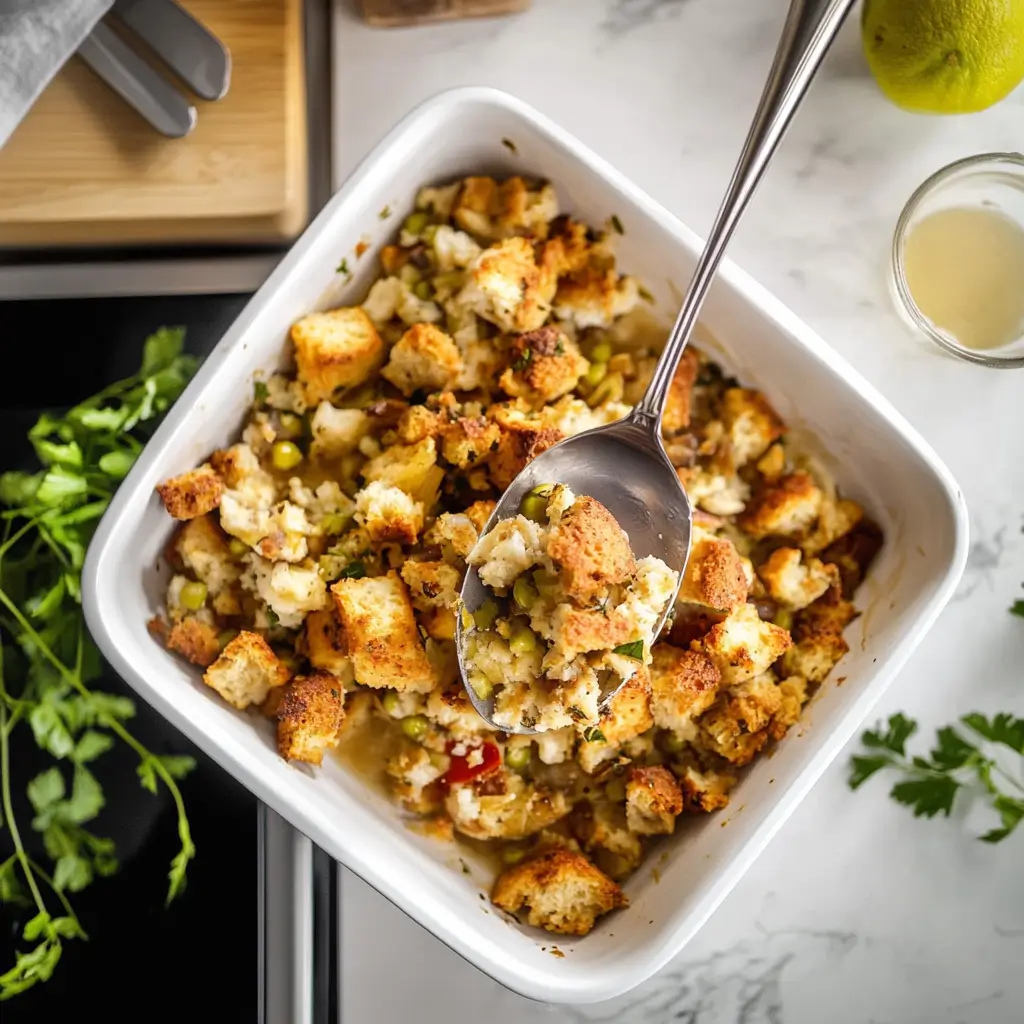
Making Ahead and Storing Classic Stuffing
Thanksgiving is already a busy day, and you might want to get a jump start by making your stuffing ahead of time. Here’s how you can do that:
Make-Ahead Instructions
Stuffing can be prepared a day or two before Thanksgiving, which can save you time on the big day. If you choose to prepare your stuffing in advance, follow these steps:
Prep the stuffing as you normally would up until the point of baking. Don’t bake it just yet.
Cover and refrigerate the stuffing in the baking dish for up to two days.
On the day you’re ready to serve, take the stuffing out of the fridge and let it come to room temperature for about 30 minutes.
Bake as directed, adding an extra 5–10 minutes if needed since the stuffing may be slightly chilled.
Tip: If you prefer your stuffing extra crispy, bake it uncovered for the last 10 minutes to allow the top to crisp up.
Freezing Instructions
If you want to make your stuffing even further in advance, you can freeze it. Here’s how:
Prepare and bake the stuffing as usual, allowing it to cool completely.
Wrap tightly in plastic wrap, then cover with aluminum foil.
Freeze for up to 3 months.
On the day you’re ready to serve, let it thaw overnight in the fridge.
Reheat in a 325°F oven, covered with foil, until heated through (about 20–30 minutes).
Tip: Freezing works best for baked stuffing. Unbaked stuffing can also be frozen, but the texture might not be as good as a freshly baked batch.
FAQs On Classic Stuffing Recipe
What is traditional stuffing made of?
Traditional stuffing is made from cubed bread, onions, celery, herbs (like sage and thyme), and broth or stock. Eggs are often added to help bind the ingredients together. Some variations may include additions like sausage, nuts, fruits, or spices to add more flavor.
Is stuffing better with or without eggs?
Eggs help to bind the stuffing together and create a cohesive texture. While you can make stuffing without eggs, using them typically results in a fluffier and more structured stuffing. If you prefer a more crumbly texture, you can skip the eggs, but they are recommended for the best consistency.
Is it better to use stock or broth for stuffing?
Both stock and broth work well for stuffing, but stock generally offers a richer flavor because it’s made by simmering bones and meat, resulting in a more robust taste. Broth is lighter and can be a good option if you prefer a milder flavor or want to reduce the richness of the dish.
What is the best seasoning for stuffing?
The best seasonings for stuffing include sage, thyme, rosemary, parsley, and a pinch of salt and pepper. These herbs give stuffing that classic holiday flavor. Some people also add garlic, poultry seasoning, or a little bit of nutmeg for extra depth.
What makes stuffing taste better?
The key to making stuffing taste better is using high-quality, flavorful ingredients. Fresh herbs, homemade or high-quality broth, and stale bread for texture all contribute to an improved taste. Additionally, adding sausage, sautéed vegetables, or fruit can enhance the flavor profile and make your stuffing stand out.
What happens if I use broth instead of stock?
Using broth instead of stock in stuffing will result in a slightly lighter flavor since broth is typically made from meat and water without the bones. While stock has a richer, more gelatinous texture that adds depth to the dish, broth will still provide moisture and flavor, especially if it’s low-sodium and well-seasoned.
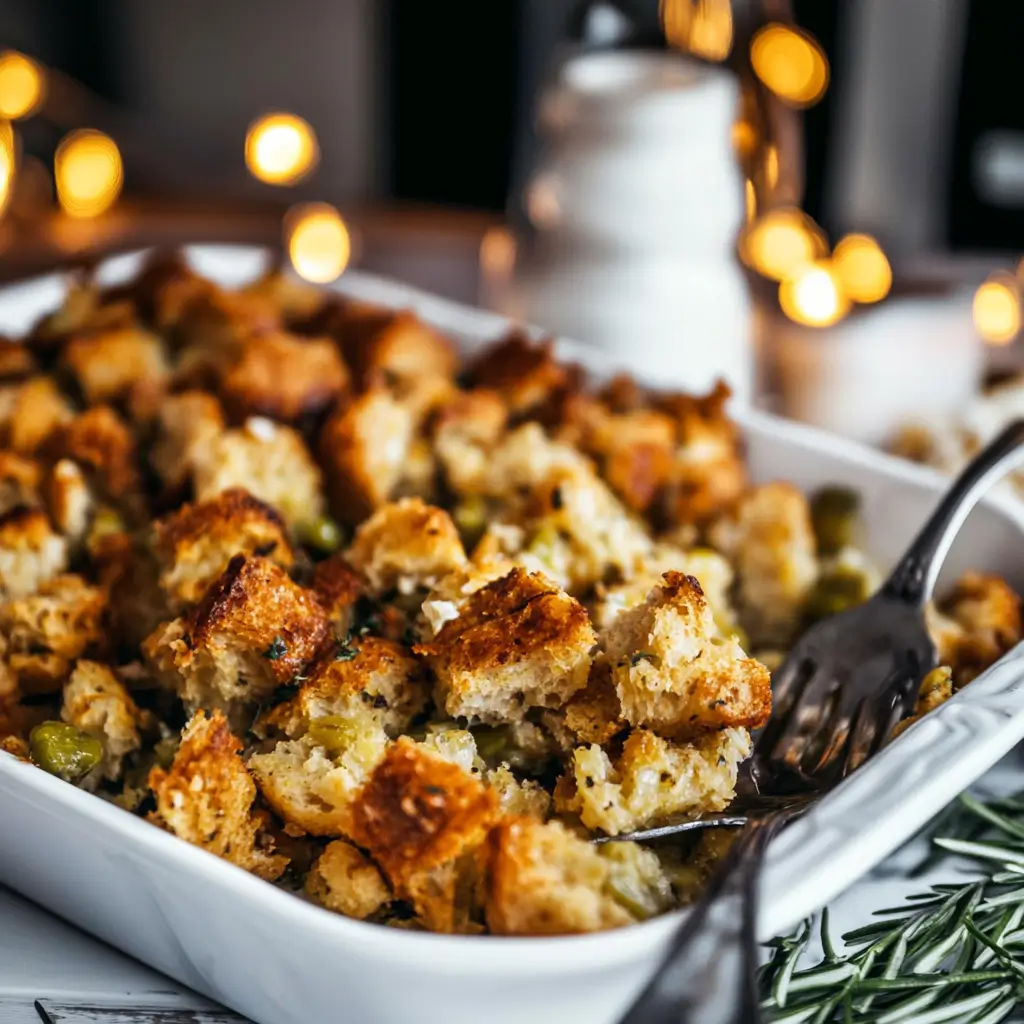
Recipe Card: Classic Stuffing Recipe
Ingredients:
16 cups (1 3/4 pounds) stale country white bread cubes (1/2-inch cubes)
1 stick unsalted butter (plus extra for greasing the baking dish)
1 onion, finely chopped
5 stalks celery, finely chopped
1 tablespoon fresh sage, chopped
1 tablespoon fresh thyme, chopped
1/2 teaspoon paprika
3 cups low-sodium chicken or turkey broth
2 large eggs, beaten
1/2 cup fresh parsley, chopped
1 tablespoon fat from turkey drippings (or use butter)
Kosher salt and freshly ground black pepper, to taste
Instructions:
Preheat the oven to 375°F (190°C). Grease a 3-quart baking dish with butter.
In a large Dutch oven or skillet, melt the butter over medium heat. Add the onion, celery, sage, and thyme. Season with salt and pepper. Cook for about 5 minutes, until the vegetables are tender and softened but not browned.
Add the chicken or turkey broth to the pan and bring it to a boil. Remove from heat.
In a separate large bowl, whisk together the eggs and parsley.
Add the stale bread cubes to the bowl with the egg mixture, then pour the hot broth and vegetable mixture over the bread. Stir gently until all the bread cubes are evenly moistened, but not soggy.
Transfer the bread mixture to the prepared baking dish. Drizzle with turkey drippings (or dot with extra butter) and sprinkle with paprika.
Cover the dish with aluminum foil and bake for 30 minutes. After 30 minutes, uncover and bake for an additional 25-30 minutes, until the stuffing is golden brown and crispy on top.
Let it rest for a few minutes before serving.
Notes:
Bread: Use day-old bread for the best texture. If you don’t have stale bread, dry fresh bread cubes in the oven at 300°F (150°C) for 20-30 minutes.
Make-Ahead: This stuffing can be assembled the day before. Cover the unbaked stuffing tightly and refrigerate for up to 24 hours. When ready to bake, bring it to room temperature for 30 minutes and then bake as instructed.
Add-Ins: For extra flavor, consider adding sausage, apples, nuts, or dried cranberries to customize the stuffing.
Nutritional Facts (per serving):
Calories: 250
Fat: 12g
Saturated Fat: 5g
Cholesterol: 50mg
Sodium: 400mg
Carbohydrates: 32g
Fiber: 2g
Sugar: 4g
Protein: 6g






